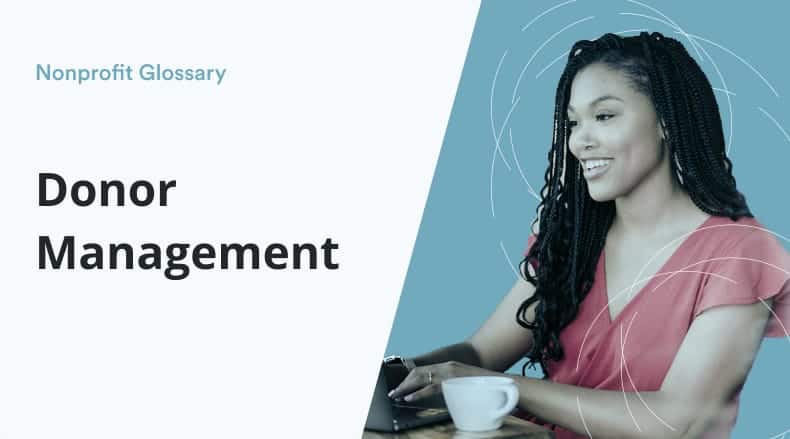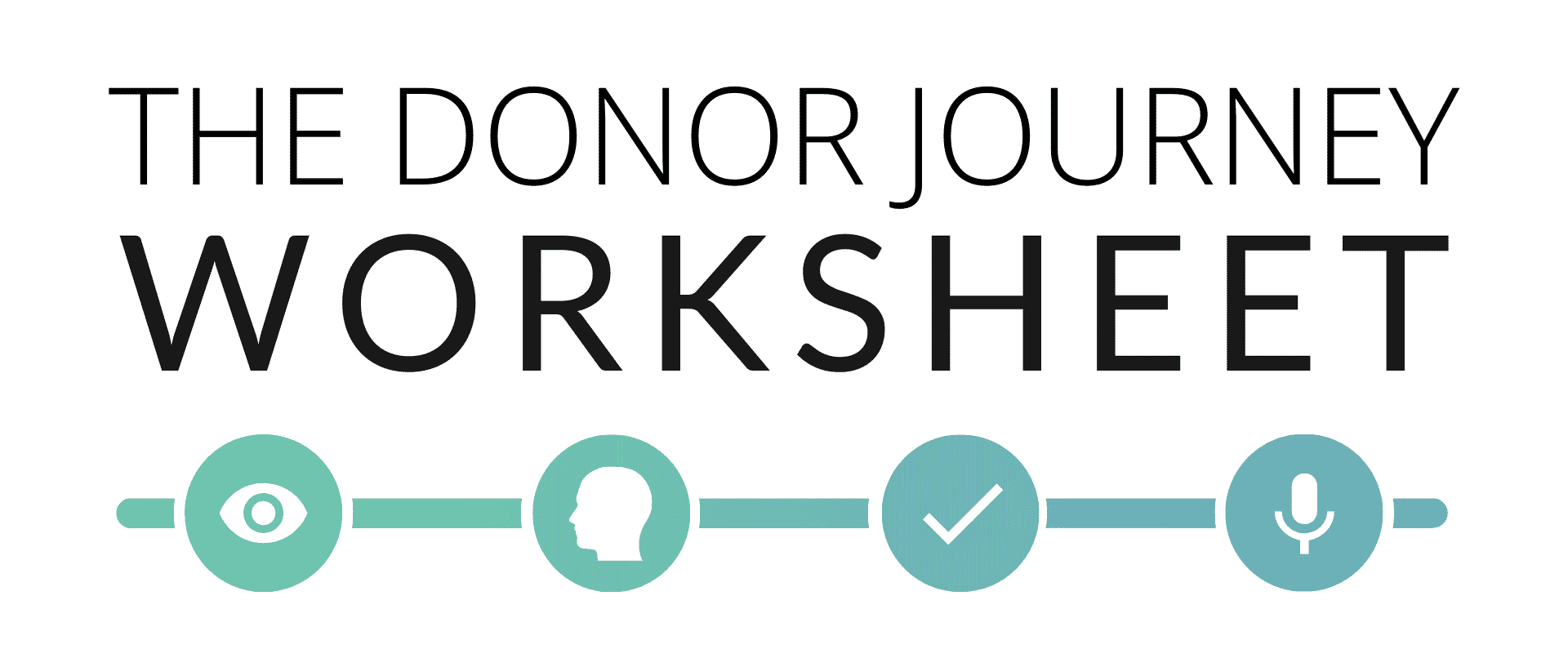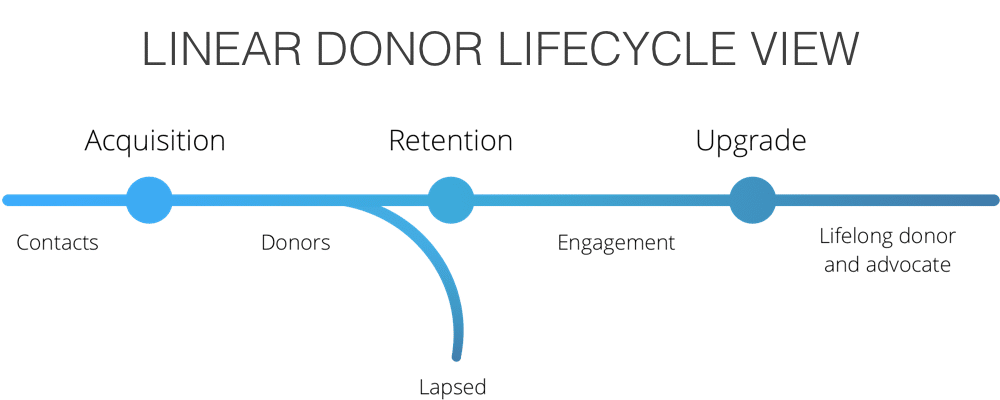Donor Management

- What is donor management?
- The donor journey
- The donor lifecycle
- Your donor database
- Communicating with your donors
What is donor management?
Donor management is the process of organizing a donor’s information, tracking your interactions with them, and maintaining your relationship with them. Because donors form the backbone of your nonprofit work, building meaningful relationships with your donors should be a central focus.
There are several ways to manage your donors’ expectations, improve their experiences with your nonprofit, and garner relationships with those looking to support your mission. Understanding your donors’ needs and expectations is integral to your success, and donor management is the means to that end.
The donor journey
The donor journey is how donors encounter your organization, commit their resources and support, and advocate to others on behalf of you and your mission. This is similar to the journey of any relationship since, at its root, it involves the resonance and response of human-to-human interactions.
There are four major stages in the donor journey. By understanding what stage a donor or potential donor is currently in, you can cater your next steps to ensure they stay engaged and committed to your organization’s continued success.

Awareness
The first stage of the donor journey is awareness, where the donor realizes they want to give to or help your nonprofit meet its goals. The level of awareness your nonprofit maintains directly affects the likelihood donors will find and decide to support your organization.
There are two methods of building awareness: outbound and inbound marketing. Outbound, or push marketing, is the process of interrupting a potential donor with your message or advertising and includes things like cold-calling, paid advertising, and trade shows. Inbound, or pull marketing, is a non-invasive method of providing donors with your nonprofit’s information when they are looking for causes related to yours.
Ensuring your nonprofit is accessible to potential donors of any kind is the best way to improve your awareness and, thereby, improve your chances of attracting new donors.
Watch our webinar with Classy on deconstructing the donor journey
Consideration
The second stage of the donor journey is consideration. Here, a donor determines a particular mission they want to support and research where to give. From your organization’s perspective, this is a make-or-break moment in your relationship with a particular donor.
You want to make sure that during the consideration process, a potential donor has everything they need to encourage them to come alongside your nonprofit and work toward your mutually realized mission. Since giving time and money to your organization is a personal investment, this is your opportunity to display the emotional side of your impact.
Decision
Now that you have made your donor aware of your organization, and they have considered ways they can get involved, the next stage in the donor journey is the donor’s decision to give to your nonprofit. Though this may seem like a “mission accomplished,” your work is not finished.
Making it easy for the potential donor to give is essential to not losing them this late in the acquisition process. By including a prominent donate button on your website and making the donation process seamless and intuitive, you can make sure the potential donor completes the process and trusts that their investment was the right one.
Evangelize
After your potential donor becomes an actual one, the final stage in the donor journey is evangelism. Now that your donor has committed to your mission and organization, ask them to share it with their friends.
By maintaining a relationship with your donors and keeping them informed of your continued success, they can become a beacon of awareness for others to potentially donate. In this way, the donor lifecycle is cyclical. By continually engaging your current donors, you create a larger circle of people dedicated to your nonprofit who can then leverage their relationships to continue your network’s growth.

Ready to map out your organization’s donor journey? Use this free donor journey map template to get started.
Get Your Free Donor Journey Map Template
The donor lifecycle
While the donor journey is a way of viewing contacts based on their path to donating, the donor lifecycle analyzes donors from a holistic perspective, from acquisition to maximum engagement. By organizing your donors along the spectrum of the donor lifecycle, you can understand the best way to engage your partners not only to give again but to deepen the relationship between them and your nonprofit.
Watch our donor lifecycle webinar
The donor lifecycle is organized with three major phases: acquisition, retention, and upgrade. While some prefer to view the lifecycle cyclically, we believe the linear model is more valuable since it correctly emphasizes the need for continual donor engagement and provides the context of donor lapse.
We understand that maintaining this amount of information for each donor can be a challenge; however, this is where a donor database can help. As we discuss below, a donor database can centralize all of your contacts to ensure you have updated information about where they are in the lifecycle.

Donor acquisition
Acquiring donors is a consistent and active process. As a nonprofit, you are always competing with other organizations for the attention of potential donors, so you need to make sure you are putting your best foot forward to welcome them into your community.
At the foundation, donor acquisition boils down to marketing and advertising. As we said above, the best thing you can do to promote your nonprofit’s awareness is to ensure that it is accessible. Two of the best ways to do this are digital marketing and digital advertising.
With digital marketing strategies, you make sure your specific campaign is compelling, easy to understand, and personalized. This improves the likelihood that those with an emotional investment in your mission will count on you to enact it.
With digital advertising strategies, you utilize networks related to your mission to propel your cause into the hands of those who are most likely to come aboard. This allows donors to have an initial trust in your organization since it’s related to those they already know.
Donor retention
Once your donors have contributed, you want to make sure they stick around to see their investment impact. Donor retention is mutually beneficial since it keeps donors engaged with causes they are interested in and ensures your organization has a consistent stream of resources.
One simple and effective donor retention strategy is creating an outstanding welcome experience and engaging with donors regularly. Alternatively, by systematically following up with unengaged donors and creating targeted educational and promotional materials, you can re-engage donors who may have lapsed.
Go to our free donor lifecycle ebook for a comprehensive guide on acquiring, retaining, and upgrading your donors.
Go To The Donor Lifecycle Ebook
Lapsed donors
A lapsed donor is one who used to contribute to an organization but who has not donated for a specific amount of time. Understanding why donor lapse occurs and creating strategies to re-engage those who may have lapsed already is key to maximizing donor retention.
Donor lapse occurs for various reasons; some are derivative of personal differences on the donor’s side, while others are due to interactions from your organization. For example, a donor may stop donating due to a personal change in circumstances or a loss of interest. Alternatively, donors may stop giving because they aren’t feeling appreciated; they stop seeing an impact or feel offended by your communication.
The easiest way to target lapsed donors is through LYBUNT & SYBUNT reports. LYBUNT and SYBUNT reports allow you to categorize your donors and understand why they may have lapsed. Additionally, LYBUNT and SYBUNT reports can help you win back lapsed donors by providing context to what kind of engagement specific donors need.
Donor upgrade
Donor upgrade is the process of increasing a donor’s giving from year to year. This is why it is essential to think of the donor lifecycle linearly instead of cyclically. While recurring donors are a vital part of your organizational stability, creating donors who contribute more year over year ensures your nonprofit’s continued growth.
The easiest way to encourage donor upgrade is through segmentation. By segmenting your donors into similar giving levels or propensity to upgrade, you can promote growth through specified targeting.
Download this free donor lifecycle worksheet, and we’ll walk you through how to improve your organization’s acquisition, retention, and upgrade of your supporters.
Download the Donor Lifecycle Worksheet
Your donor database
Now that we’ve covered how the typical donor operates and understand what donor information you should collect, the next step is to discuss how to organize and manage that information. This is where a donor database comes in.
Effectively utilizing a donor database can maximize your nonprofit’s impact since you know who and how to target. With a donor database, you can segment your contacts to encourage donor upgrade, utilize search queries to manipulate large amounts of data at once, and focus on the most relevant donor data to ensure your team makes the right decision with marketing and outreach initiatives.
The best way to implement a donor database is by investing in donor management software. Donor management software allows you to save time and boost fundraising by managing all the information relevant to your donor and their experience with your organization.
By utilizing the right donor management software, you can organize donors’ data, identify trends, categorize your donors into lists and segments, and improve your donor’s experience through fundraising tools and enhanced communication.
Donor data & metrics
One benefit of a donor management platform is the ability to develop relationships with donors in ways curated to their specific needs and interests. Because keeping up to date with each individual donor is often outside the scope of possibility, donor data and metrics can provide you with the necessary feedback directly from your partners.
Additionally, donor databases allow you to utilize donor metrics to measure your fundraising and marketing performance. Having updated donor metrics enables you to judge whether your outreach efforts correlate to real growth in fundraising or whether communications strategies need to be changed. This can be vital to reducing donor lapse and increasing donor upgrade.
Donor reports
Another benefit of utilizing a donor management platform is the ability to run reports that show you the types of donors contributing to your organization. By running different types of donor reports, you can understand which of your donors requires targeted attention and care and which ones you can count on year after year.
Additionally, many donor management platforms let you set up automated reports, which allow you to schedule data reports which are then sent to you automatically. This will enable you to spend less time manually pulling reports and more time actively engaging your donors.
Watch the top 5 reports for nonprofits
Communicating with your donors
Communication is key to the continued flourishing of any relationships, and donor relationships are no different. By investing in the communication tools and strategies that mesh with your nonprofit’s culture and mission, you indicate that your donors are a valuable part of your team.
Improving your communication with donors can take many forms. Some communication efforts like cleaning up your mailing list and donor segmentation are proactive ways of reaching your partners in relevant ways. Like sending thank you letters, others are examples of best practice and reactive methods that make your donors feel connected to your team and work.
Donor segmentation
As we highlighted earlier, donor segmentation helps you build donor relationships by allowing you to better understand the way related donors interact with your message and mission. By segmenting your donors by giving level and targeting them effectively, you can garner more donations by making asks and thanking donors in a targeted manner.
While segmentation by giving level is a standard method, you can also organize your donors into lists based on location, communication type, and related interests. This type of segmentation allows you to customize the way you reach out to donors and gives them even more relevant information about your needs and impact.
Watch our webinar on donor segmentation
Thanking your donors
Thanking your donors is by far the most important part of your nonprofit’s communication strategy. Not only does it give your donor the gratitude they deserve, but it also provides them with an acknowledgment that you received their donation and gives you another opportunity to communicate with them about your mission.
This should not be a tedious afterthought; instead, we recommend that you thank your donors quickly and personally. Have fun with it! Your donors care about your organization; show them you appreciate their partnership.
Bottom line
Donor management is the process of leveraging your donor data to build meaningful relationships with your supporters. A donor database, such as a CRM and donor management platform, is the best way to keep your donor data organized and nurture your relationships.
Learn more about how Kindful’s donor management features can help you build better relationships with your donors.